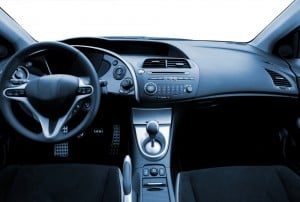 In the ’50s, rental car company Hertz used the advertising slogan: Let Hertz put you in the driver’s seat.
In the ’50s, rental car company Hertz used the advertising slogan: Let Hertz put you in the driver’s seat.

This catchphrase was an appeal to our natural desire for control — a theme that plays continuously in advertising. In 2010 for example, National Car Rental ads showed how customers could register online, avoid the counter and pick any car in the lot. The campaign featured tennis star John McEnroe, famous for his mid-match tantrums, discovering he can select any car he wants and shouting, “Choose any car? You cannot be serious!”
The American road represents freedom and autonomy, and the most successful rental car companies position themselves as facilitators of the driver’s autonomy. Most car rental companies had already given drivers some control over the rental process by letting them choose the size or request a specific model. But National Car Rental went a step further to let the customer choose any specific car they wanted!
Companies Tend to Their Wants
Companies naturally tend to their own wants (the desire for profit), and this frequently happens at the expense of customers or employees. Corporations thrive on structured organizations that allow them to control outcomes as closely as possible. This often means customers are given little autonomy (e.g., a product that is sold in only one way). But when companies give some degree of ownership to consumers, such action can become a support on the bridge connecting the consumer and company. Simply put, giving control is one of the most effective ways to foster a consumer motivation that supports a company’s brands.
Consider the “self-determination theory” developed by psychologists Richard Ryan and Edward Deci: It postulates that positive behavior is in part a consequence of intrinsic motivation. The difference between intrinsic and extrinsic motivation can be illustrated through the example of cleaning a house. Teenagers will begrudgingly vacuum the living room because they are told to, not because they care if the room is clean. This is extrinsic motivation, coming from an outside source. Adults on the other hand will vacuum for the personal satisfaction of getting their house clean. In other words, they are intrinsically motivated.
Give the Customer Control
For businesses, this translates into providing customers with greater control over their purchasing decisions, allowing customers to experience their buying behavior as self-determined and internally motivated.
Affording consumers some measure of control over the brand relationship isn’t only a smart marketing practice because it helps customers “feel good,” but it also offers customers the opportunity to internalize their decisions and feel that the outcome of their buying decisions is genuinely self-directed. Not only will they experience a greater sense of satisfaction (and achievement) from their purchases, but they will hold themselves accountable for a purchased product’s success or failure. When customers view themselves as in control, they will often take risks, such as trying new services or taking a chance on a new product.
For example, when the Apple iPod came out, it was a radical innovation in terms of allowing consumers to control what they listened to. Music consumers no longer needed to wade through an entire collection of songs to enjoy the two or three they wanted to hear. The iPod users were their own DJs, putting together playlists as they skipped from album to album or experiencing a sense of discovery by setting their iPod to “random.” Apple innovators showed a clear understanding of people’s deep desire to control their music.
However, control wasn’t just reflected in the product itself when the iPod appeared. Control also played a key role in Apple’s ad campaign. A highly successful series of iPod commercials spotlighted artists including Eminem and Lady Gaga who are known especially for their individuality and non-conformism. These ads contained neither pitchman nor slogan — only silhouettes of iPod users dancing wildly — which let the personality of the featured artist or song make the point: Listen to the music you want to listen to, and be the person you want to be.
Satisfaction Equals Loyalty
Satisfying customers’ desire for control offers the highest potential for a company to build enduring loyalty. If enough people buy into a brand’s products or services out of intrinsic motivation, growth will follow. Contrary to traditional “wisdom,” the key to making that happen is to relinquish control to your customers.
Photo courtesy of Nejron Photo / Shutterstock.com


